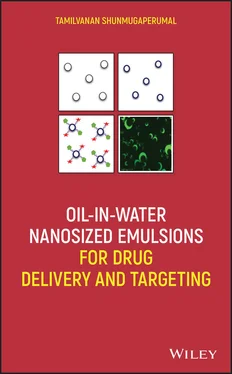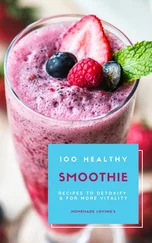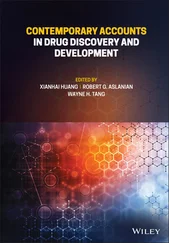Oly Katari, Research scholar, Department of Pharmaceutics, National Institute of Pharmaceutical Education and Research (NIPER), Guwahati, Assam, India
Datta Maroti Pawde, Research scholar, Department of Pharmaceutics, National Institute of Pharmaceutical Education and Research (NIPER), Guwahati, Assam, India
Syed Nazrin Ruhina Rahman, Research scholar, Department of Pharmaceutics, National Institute of Pharmaceutical Education and Research (NIPER), Guwahati, Assam, India
Tamilvanan Shunmugaperumal, Department of Pharmaceutics, National Institute of Pharmaceutical Education and Research (NIPER), Guwahati, Assam, India

It gives me an immense pleasure to write foreword for a book written by my colleague. This book provides comprehensive information concerning the oil‐in‐water nanosized emulsions as drug delivery carrier and drug targeting purpose. Very importantly, the generations of nanosized emulsions are updated according to the present‐day research focus, especially for reachable and unreachable organs/parts of the human body and thus, permitting the target place‐precised drug delivery and/or improved drug bioabsorption. A dedicated section covered in this book under heading, “Biofate of Nanosized Emulsions,” after their administration via different routes (dermal, nasal, ocular and parenteral) is a subject matter of interest for researchers. I strongly feel that this book will serve as a guide for formulation scientists working on oil‐in‐water nanosized emulsions in academic and industry levels.
DR. USN MURTY
Director
National Institute of Pharmaceutical Education and Research (NIPER), Guwahati, Assam, India
Over the years, so many new chemical entities (NCE) are constantly being discovered/designed/synthesized and even sometimes few NCE claim to be “molecular breakthrough” showing additional/exceptional better therapeutic activities in managing/treating single or multiple ailments. The so‐called molecular breakthrough NCE, in most of the times, are unable to provide the intended therapeutic application as they were thought initially. Thus, a question has come to find out the answer “why the sudden lacuna that prevents the successful development of NCE from laboratory to market (L‐to‐M).” In the present scenario, the L‐to‐M consists of multiple stages that include laboratory‐scale preformulation studies, systematic optimization of a formula to incorporate the NCE into the selected formulation, NCE‐incorporated formulation characterization and safety assessment at non/preclinical levels, clinical trials using the optimized NCE‐laden formulation including the toxicity assessment at multicentric levels, patenting and regulatory approval processes, market assessment, targeting and positioning of final product, etc. Although each stages of product development require considerable/significant attention and care, the preformulation and formulation development stages become a cutting‐edge decision‐making stage where the formulation development scientist will decide whether to allow the NCE‐laden formulation to proceed for further stages or to send back the NCE to the previous NCE design/discovery/synthesis stage. Furthermore, the cutting‐edge decision‐making stage is very important in industrial point‐of‐view to avoid any further utilization of manpower, money, and time on a particular molecular breakthrough NCE.
Ranging from 40 to 70%, the molecular breakthrough NCE possess exceptionally water‐insoluble characteristics and therefore compelling the formulation developers to look into or to go for any suitable formulation that may fit for the selected NCE rather than simply trying to make aqueous/nonaqueous‐based solution‐type formulation. One of the amazing drug delivery carrier systems that suit for such NCE is oil‐in‐water (o/w)‐type nanosized emulsions. The o/w nanosized emulsions possess the success stories for taking the active pharmaceutical ingredients (APIs) into desirable target organs of human body, particularly in terms of non‐parenteral (especially ocular) and parenteral routes. The in‐or‐new‐born internal structures observed in the dispersed oil droplets of o/w nanosized emulsions are the welcome additions in emulsion technology wherein two or three API molecules can easily be accommodated simultaneously during the emulsification time itself. Such recent observations of in‐or‐new‐born internal structures in the o/w nanosized emulsions include “Cerberus and Janus” and corresponding names given to the emulsions are Cerberus emulsions and Janus emulsions. These types of new emulsions, although at their rudimentary stage of development, are capable of escalating the o/w nanosized emulsion's utility in multiple directions viz., drug solubility enhancers, dual/triple drug‐loading vehicle, imaging and theragnostic purposes, etc.
This book provides very comprehensively the details of o/w nanosized emulsions at the grass‐root level so that the formulation scientist can understand how to select the proper excipients such as emulsifier combination, oil or oil combination, and other ingredients to systematically optimize the emulsion formula matching with ICH guidelines Q8(R2), Q9, and Q10, to characterize the emulsions and perform safety assessment, to monitor the biofate of nanosized emulsions, etc. All these abovesaid issues are detailed in this book with few case studies wherever possible.
Chapter 1starts with terminology confusion prevailing about emulsion in medical and pharmaceutical fields. The purpose of this section is to clarify the terminology needed to indicate authentically this drug delivery/targeting system and finally gives reasons for judicious selection of the term “nanosized emulsion.” It will also provide generations of oil‐in‐water nanosized emulsions so far developed with short justification followed by a brief description regarding the purpose and contents of the book.
Chapter 2introduces the quality‐by‐design (QbD) approach applied onto the emulsion optimization during the preformulation studies. The effect of amount of NCE or lipophilic drug, quantity of excipients (oils, emulsifiers, and other excipients) onto the drug incorporation patterns, final particle size distribution of dispersed oil droplets of the emulsion, stability of final emulsion over different temperature conditions, etc., are the subject of interest discussed in this chapter.
Chapter 3provides an overview of how nanosized emulsions are serially or systematically characterized to meet the requirements against physical, chemical, biological, and safety points of view. Safety evaluations using animal or human volunteers and cell‐culture models are separately discussed in terms of the requirements needed by the regulatory agencies for allowing the emulsions to undergo clinical trials and then, commercial usage.
Chapter 4shows how changes in terms of formulation excipients were being constantly made on the nanosized emulsions over the last few decades. To understand better this changeover process, the o/w nanosized emulsions are classified based on the generations with decade‐wise gap.
Chapter 5arranges the various issues relevant to the o/w nanosized emulsions to implicate in parenteral and ocular drug delivering systems. Understanding the mechanisms of interactions between emulsion droplets and plasma protein components helps the formulation developers to design long‐circulating stealth emulsions for parenteral drug delivery and drug targeting purposes. Similar attention is also being given to the consequences of nanosized emulsions following ocular topical instillation or intraocular injection. The published reports in conjunction with these points are covered thoroughly in this chapter.
Читать дальше













